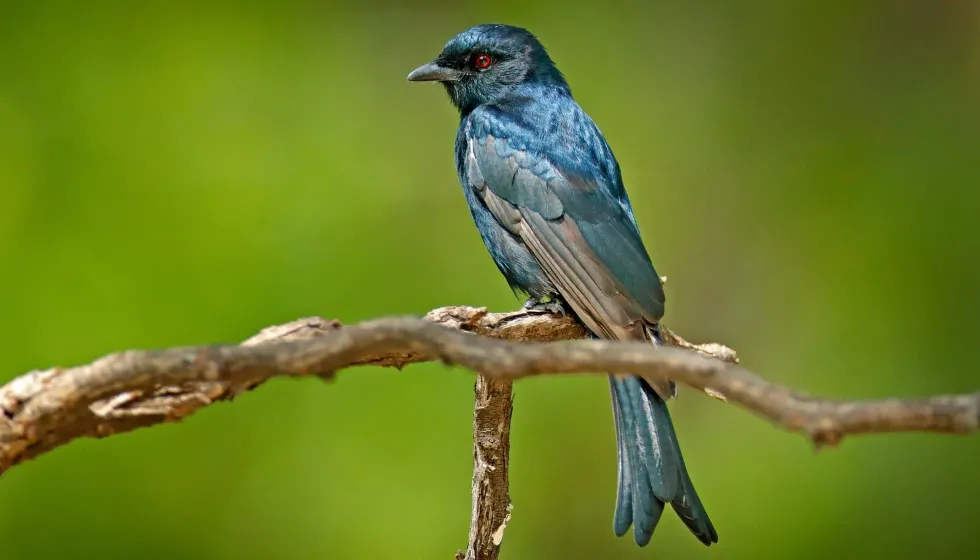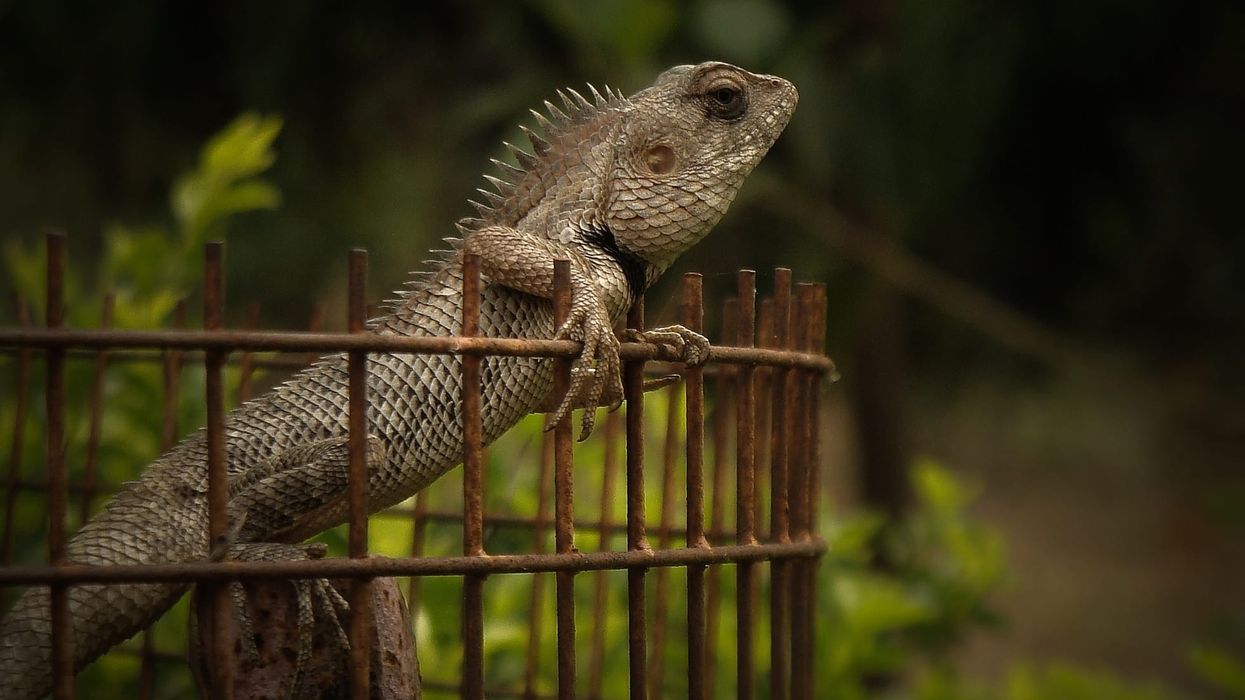Fork-tailed drongo, Dicrurus adsimilis belong to the family of Dicruridae. These birds are found mainly in the South of Africa and live in an extensive range of habitats like forests, bush, farmlands, gardens, and parks.
They make their nest 13-16 ft (4-5 m) above the ground. The nest is placed on a forked region of a tree and is made of tree leaves, twigs, and spider webs. This Drongo bird species is extremely territorial about their nest in nature.
The breeding pairs feed the nestlings till they ready to find their own prey. This bird species often sit upright on trees and hunt.
If the young are threatened, they drive the predator away by a process called mobbing. Males have glossy black plumage and a fork-shaped tail, which is how they get their name.
Females don't have as glossy feathers as males. This is mainly how the identification between them takes place.
These wondrous birds of the world also have a strong black bill and red-colored eyes. The wings have a lighter shade than their tail and body. Drongo the fork-tailed bird has unique mimicking features.
They are known to make deceptive calls in order to distract other animals from their prey. The calls made by Fork-tailed Drongo, meerkat can be so identical that they often get confused and abandon their prey.
For more relatable content, check out these swallow-tailed kite facts and brant facts for kids.
Fork-Tailed Drongo Interesting Facts
What type of animal is a fork-tailed drongo?
Fork-tailed drongo is a kind of bird.
What class of animal does a fork-tailed drongo belong to?
Fork-tailed drongo belongs to the class called Aves.
How many fork-tailed drongos are there in the world?
The exact number of these drongos has not been listed.
Where does a fork-tailed drongo live?
These fork-tailed drongo living in Sahara desert, are found predominantly in South Africa.
What is a fork-tailed drongo's habitat?
Fork-tailed drongo, Dicrurus adsimilis live in forest and bush areas, farmlands with scattered trees, savanna woodlands, in tropical, temperate regions. They favor arid climates. These birds are also spotted in gardens and parks.
Who do fork-tailed drongos live with?
Fork-tailed drongos are usually solitary birds. They are however observed in pairs during the breeding season.
How long does a fork-tailed drongo live?
There is no exact data available on how long a fork-tailed drongo lives.
How do they reproduce?
Just like the house wren and black vultures, these black-colored drongo, the fork-tailed bird, are monogamous birds. The breeding season of these birds lasts from January till August.
These birds build cup-shaped nests with thin walls, made of leaves, twigs, and spider web strands. The nests are placed 13-16 ft (4-5 m) above the ground, like a hammock un between the forked tree. Females lay around 2-4 eggs during this time.
The eggs can have a range of different colors. The incubation period lasts for around 16-22 days.
The nest or young ones are fed by both males and females after birth. These birds are aggressive and fearless in nature and even attacks larger birds if they feel the young birds are threatened. When the young are threatened, in the presence of a predator nearby, they start mobbing.
In this method, they surround the predator and attack to drive it off. These birds are also known to host the birds of two species of cuckoos, namely the Jacobian and African cuckoos.
What is their conservation status?
Fork-tailed drongos are given the status of Least Concern by the IUCN Red List. These birds have a large distribution and the population has remained stable. Hence, no special conservation measures have been undertaken to preserve these birds.
Fork-Tailed Drongo Fun Facts
What do fork-tailed drongos look like?
Males have glossy, black plumage. The wings are lighter in color. The female is entirely black but is less glossy than males.
This is how the identification between the male and female species is made. These birds have relatively large heads and smaller legs. They have a forked tail that is curved on the outside. They also have red eyes and strong bill.
These medium-sized birds have fine nasal and rictal bristles. The flight feathers are asymmetrical in shape but are paired in a synchronized and symmetric way. These feathers are curved around the edges.
How cute are they?
Drongos, Dicrurus adsimilis, are very adorable to look at. This aggressive and fearless bird species has a forked tail and black-colored bill. This primarily adds to its cuteness factor.
How do they communicate?
The fork-tailed drongo (Dicrurus adsimilis) communicate with each other by making various kinds of calls. These birds often mimic different kinds of alarm calls in order to steal food from other animals.
They are especially known to mimic meerkats and babblers. The call of this bird species is called metallic bird strink. These birds are also known to make false alarm calls to leopards and other animals in order to annoy them.
They also make their own calls, specific to their own species to communicate with each other. They also make unmelodic and harsh noises while communicating with each other.
How big is a fork-tailed drongo?
The drongo species are medium-sized. They are 8.6-9.8 in (22-25 cm) in length.
How much does a fork-tailed drongo weigh?
The average weight of this bird species is around 1.4-1.7 oz (40-50 g).
What are the male and female names of the species?
No specific names have been given to the male and female birds of this species.
What would you call a baby fork-tailed drongo?
Nestlings or young ones of this bird species is called chicks or nestlings.
What do they eat?
The bird species from South Africa, the drongo, Dicrurus adsimilis are omnivorous in nature. They hunt while sitting upright on a perch.
They catch their prey, like insects, fish while they are in flight. They are also known to eat seeds, nectar, and fruits in the arid region.
These birds are also kleptoparasites meaning they steal food from other animals by mimicking false alarm calls of meerkats. Often these birds are seen sitting on tree perch, above a foraging mongoose, waiting to snatch away their hard-earned food whenever they get a chance. These birds are also known to hunt small invertebrates and vertebrates.
Their food consists of a variety of insects like bees, termites, beetle larvae, moths, ticks, and caterpillars. They also hunt lizards, and fish at times.
Are they poisonous?
These wondrous birds of the world are not known to be poisonous.
Would they make a good pet?
These drongo birds are aggressive birds, fighting with much larger animals to keep them out of their territory. Human beings haven't been able to domesticate these birds as of yet. Their hostile behavior makes it difficult to keep them as pets.
Did you know...
These unique birds of the world are also known as kleptoparasites. This means they live a life where they rob food from other mammals by making loud deceptive calls, by mimicking the calls of various mammals.
These black drongos, from the South of Africa, got their name based on the shape of its tail. They have a fork-shaped tail which is very unique of its species.
Fork-tailed drongo, cuckoo are very similar looking. Often they host the eggs of cuckoos.
These drongos are mainly found in the South of Africa and have made several life adaptations to survive. Even though these folks are predominantly carnivorous, they also survive on nectar and seeds in difficult situations.
Fork-tailed drongo, belonging to the family of Dicruridae, living in forests, sits very upright and hunts flying insects. They also make cup-shaped nests and the breeding pairs fight with its life to protect their nestlings from predator attacks
How does the fork-tailed drongo use mimicry?
This unique black-colored bird of the world uses mimicry to steal food from other animals. They make false alarm calls by following them around. As soon as they spot another animal hunting down prey, by mimicking the calls, they drop their food and flee. This is how they hunt the majority of their food.
What behavioural adaptations does a fork-tailed drongo have?
These black-feathered bird species have made several modifications to adapt and survive. Even though these animals are carnivorous in nature, they often eat foods that range from nectar to seeds when they are in Arid regions.
Here at Kidadl, we have carefully created lots of interesting family-friendly animal facts for everyone to discover! For more relatable content, check out these Hawaiian hawk facts and griffon vulture facts pages.
You can even occupy yourself at home by coloring in one of our free printable fork tailed drongo coloring pages.









